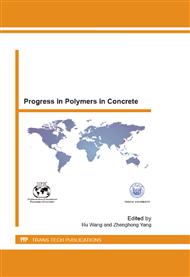p.490
p.495
p.502
p.508
p.514
p.520
p.527
p.532
p.538
Manufacture of Masonry Mortars with Melamine Powder Waste and Melamine Paper from the Manufacture of Agglomerated Particle Boards
Abstract:
Our presentation develops the study of cement mortars manufactured with melamine waste, either in the form of powder or cellulose paper, taken from the industrial production of particle boards, characterizing all of their properties and comparing them with traditional cement mortars. The objective is to determine in what way the addition of melamine powder and melamine paper will modify traditional mortar, once these materials have been subjected to a polymerization process under pressure and under increased temperature, in order to assess the possibility of using these new materials for applications in the construction industry. The behaviour of mortar in the fresh state is studied, determining the variations produced with the addition of melamine powder and melamine paper on the workability and the on-site use of these mortars. Likewise, their mechanical properties under flexion, compression, and adherence to a ceramic surface are studied and compared with those obtained from the reference mortar. Water absorption by capillary action and vapour permeability are also studied, in order to understand the interaction of the polymerized melamine in the capillary network of the mortar. Dosages were prepared for a reference mortar and a further two series of mortars with different quantities of melamine powder and melamine paper, together with cement, sand and water. In this first phase, the use of additives in the mixtures was not considered. The process of selecting the materials and the dosage criteria of the mixtures are subsequently described. The results of the study show that the use of powder melamine and paper cellulose melamine can be used to manufacture mortars with properties that are equivalent to traditional mortars, although further studies with greater precision will be needed on the contribution of the melamine polymerization process to the internal structural cohesion of the mortar.
Info:
Periodical:
Pages:
538-543
Citation:
Online since:
April 2013
Authors:
Keywords:
Price:
Сopyright:
© 2013 Trans Tech Publications Ltd. All Rights Reserved
Share:
Citation:


